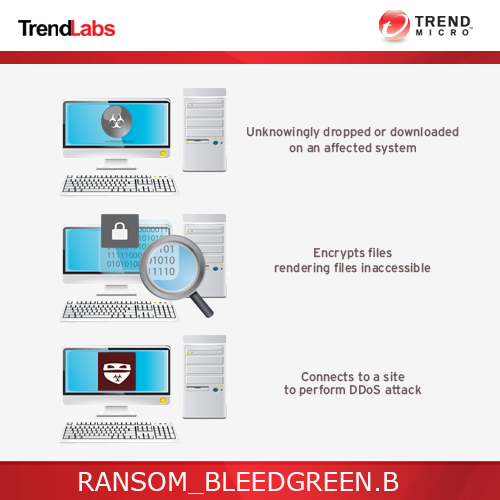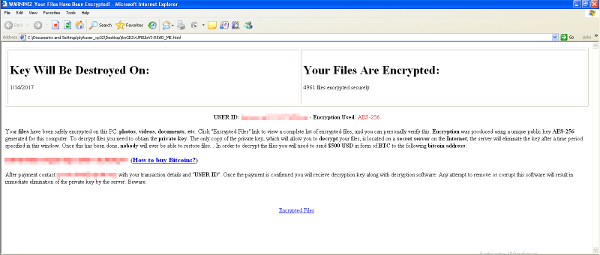RANSOM_BLEEDGREEN.B
Ransom:Win32/Firecrypt.A(Microsoft)
Windows


Threat Type: Trojan
Destructiveness: No
Encrypted: No
In the wild: Yes
OVERVIEW
Dropped by other malware, Downloaded from the Internet
This malware (discovered early January 2017), aside from encrypting files and terminating processes, can perform a DDoS attack by repeatedly connecting to a non-malicious URL.
To get a one-glance comprehensive view of the behavior of this Trojan, refer to the Threat Diagram shown below.

This Trojan arrives on a system as a file dropped by other malware or as a file downloaded unknowingly by users when visiting malicious sites.
TECHNICAL DETAILS
18,432 bytes
EXE
Yes
05 Jan 2017
Performs DDOS attack, Drops files, Terminates processes, encrypts files, renames encrypted files,
Arrival Details
This Trojan arrives on a system as a file dropped by other malware or as a file downloaded unknowingly by users when visiting malicious sites.
Installation
This Trojan drops a copy of itself in the following folders using different file names:
- %Start Menu%\Programs\Startup\{random filename}.exe - Startup Executable
(Note: %Start Menu% is the Start Menu folder, where it usually is C:\Documents and Settings\{user name}\Start Menu on Windows 2000, Windows Server 2003, and Windows XP (32- and 64-bit); C:\Users\{user name}\AppData\Roaming\Microsoft\Windows\Start Menu on Windows Vista (32- and 64-bit), Windows 7 (32- and 64-bit), Windows 8 (32- and 64-bit), Windows 8.1 (32- and 64-bit), Windows Server 2008, and Windows Server 2012.)
It drops the following files:
- %Desktop%\{random characters}-filesencrypted.html - List of encrypted files
- %Application Data%\SysWin32\files.txt - List of encrypted files
- %Desktop%\{random characters}-READ_ME.html - ransom note
(Note: %Desktop% is the desktop folder, where it usually is C:\Documents and Settings\{user name}\Desktop in Windows 2000, Windows Server 2003, and Windows XP (32- and 64-bit); C:\Users\{user name}\Desktop in Windows Vista (32- and 64-bit), Windows 7 (32- and 64-bit), Windows 8 (32- and 64-bit), Windows 8.1 (32- and 64-bit), Windows Server 2008, and Windows Server 2012.. %Application Data% is the Application Data folder, where it usually is C:\Documents and Settings\{user name}\Application Data on Windows 2000, Windows Server 2003, and Windows XP (32- and 64-bit); C:\Users\{user name}\AppData\Roaming on Windows Vista (32- and 64-bit), Windows 7 (32- and 64-bit), Windows 8 (32- and 64-bit), Windows 8.1 (32- and 64-bit), Windows Server 2008, and Windows Server 2012.)
It creates the following folders:
- %Application Data%\SysWin32
(Note: %Application Data% is the Application Data folder, where it usually is C:\Documents and Settings\{user name}\Application Data on Windows 2000, Windows Server 2003, and Windows XP (32- and 64-bit); C:\Users\{user name}\AppData\Roaming on Windows Vista (32- and 64-bit), Windows 7 (32- and 64-bit), Windows 8 (32- and 64-bit), Windows 8.1 (32- and 64-bit), Windows Server 2008, and Windows Server 2012.)
Process Termination
This Trojan terminates the following processes if found running in the affected system's memory:
- taskmgr
Download Routine
This Trojan accesses the following websites to download files:
- http://www.pta.gov.pk/index.php - non-malicious URL
Note: The malware repeatedly connects to this URL, to perform its DDOS attack.
It saves the files it downloads using the following names:
- %User Temp%\{random characters}-{number of downloaded files}.html - contents of the URL above.
(Note: %User Temp% is the user's temporary folder, where it usually is C:\Documents and Settings\{user name}\Local Settings\Temp on Windows 2000, Windows Server 2003, and Windows XP (32- and 64-bit); C:\Users\{user name}\AppData\Local\Temp on Windows Vista (32- and 64-bit), Windows 7 (32- and 64-bit), Windows 8 (32- and 64-bit), Windows 8.1 (32- and 64-bit), Windows Server 2008, and Windows Server 2012.)
Other Details
This Trojan encrypts files with the following extensions:
- .aep
- .asp
- .aspx
- .csv
- .csx
- .doc
- .docx
- .htm
- .html
- .jpg
- .mdb
- .mp3
- .php
- .png
- .psd
- .sln
- .sql
- .torrent
- .txt
It renames encrypted files using the following names:
- {original filename and extension}.firecrypt
NOTES:
This ransomware displays the following after execution:

SOLUTION
9.800
13.146.06
09 Jan 2017
13.147.00
10 Jan 2017
Step 1
Before doing any scans, Windows XP, Windows Vista, and Windows 7 users must disable System Restore to allow full scanning of their computers.
Step 2
Note that not all files, folders, and registry keys and entries are installed on your computer during this malware's/spyware's/grayware's execution. This may be due to incomplete installation or other operating system conditions. If you do not find the same files/folders/registry information, please proceed to the next step.
Step 3
Restart in Safe Mode
Step 4
Search and delete these folders
- %Application Data%\SysWin32
Step 5
Search and delete this file
- %Desktop%\{random characters}-filesencrypted.html
- %Application Data%\SysWin32\files.txt
- %Desktop%\{random characters}-READ_ME.html
- %User Temp%\{random characters}-{number of downloaded files}.html
Step 6
Restart in normal mode and scan your computer with your Trend Micro product for files detected as RANSOM_BLEEDGREEN.B. If the detected files have already been cleaned, deleted, or quarantined by your Trend Micro product, no further step is required. You may opt to simply delete the quarantined files. Please check this Knowledge Base page for more information.
Step 7
Restore encrypted files from backup.
Did this description help? Tell us how we did.

